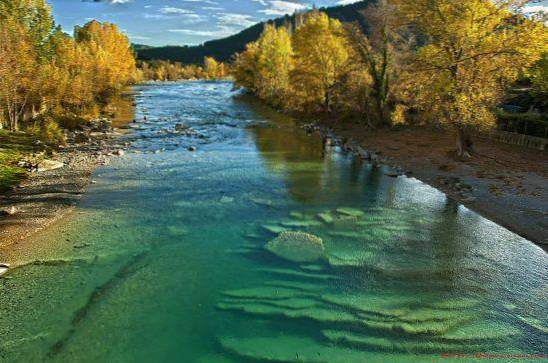
What is Potamology?
The potamology or fluviology is the science that deals with the study of water courses such as rivers and streams. It belongs to the field of study of hydrology and etymologically comes from the Greek "potamon" which means river, and "logos" which means study.
Potamology is dedicated to the biological, geographical and hydraulic study of water courses. It includes river hydraulics and all phenomena related to erosion and sedimentation with respect to water courses, without neglecting the study of river fauna and flora and that associated with the rupicolous environment..

The original approach to potamology (until the middle of the 20th century), studies rivers with primarily economic objectives: obtaining hydroelectric energy through the construction of dams, the rectification of courses and the construction of locks for navigation.
Ecological approaches oriented towards river systems have since been developed..
In these areas of study, multiple physical, chemical and biological events happen continuously, therefore, potamology is a science that encompasses various scientific disciplines.
Potamology as a study science has relevant characteristics that differentiate it from other branches of hydrology and hydrography.
Article index
- 1 Origin
- 2 What does potamology study?
- 3 Flow regimes
- 3.1 Classification of flow regimes
- 4 References
Source
The Mississippi River, called the fourth largest river system in the world and the number one in North America, witnessed and caused massive floods in 1927. These disasters impacted so negatively on society and the economy of the United States that it was decided to study the river to prevent future accidents.
The disciplines applied for the prevention of natural disasters caused by rivers, economic interest, hydroelectric power and others, are incentives of potamology. This was conceived as a comprehensive science that required the knowledge of engineers, biologists, geologists and some references from other sciences.
The origin of potamology is encapsulated in a compendium of river engineering knowledge that covers a large area of study since 1940.
What does potamology study?
A river is a stream of water that flows through a channel on the surface of the ground. The passage where the river flows is called the "river bed" and the land on either side is called the shore..
A river begins in highlands like hills or mountains and flows downward due to gravity. A river starts out as a small stream, and gets bigger the further it flows.
Many names for small rivers are specific to geographic location. For example "current" in some parts of the United States. "Gorge" in Scotland and northeast England. "Arroyuelo" in the north of England.
Potamology is the scientific study of rivers, and covers all general and specific knowledge that is related to rivers.
Flow regimes
Precipitation, temperature, evaporation due to sunlight and other factors influence the variability of a river's flow.
This means that there are various elements that change the flow of water in a river. These changes and the set of factors that produce them are known as flow regimes or fluvial regimes..
For example, the rivers of the Himalayas are perennial and their regimes depend on the pattern of water supply that occurs through melting snow and rain..
Its regimes are glacial and monsoon. Glacial because they depend on melting snow and monsoons because they depend on rain.
The regime of most of the peninsular rivers of India, on the contrary, are only monsoon, since they are controlled by rain exclusively.
Flow regimes can change on a monthly basis depending on climatic and ecological conditions.
A river can be at its maximum (with the water all the way up, almost coming out of the banks) in January, and then be completely dry in March.
Classification of flow regimes
There are basically three types of flow regime:
1-Simple regimes: they can be glacial, snowy or pluvial, depending on the origin of the water.
- The glacial regime it is characterized by:
Very high flow in summer after melting of ice. Very low flow from late fall to early spring. Very high daily variability in flow during the year. High flow (several hundred l / s / km2).
It is found at high altitudes, over 2,500 meters. Example: the river Rhône in Brigue.
- The snow regime it is similar to glacial but attenuated and the maximum flow occurs earlier, in June. They can be mountain rivers or plain rivers. The characteristics of the snowy plain (example: Simme in Oberwi) are:
Short and violent flooding in April-May after the massive spring thaw of winter snows. Great daily variability. Great variability throughout the year. Great interannual variability. Significant flow.
- The rainfall regime it is characterized by:
High water flow in winter and spring. Low flow in summer. Great interannual variability. The flow is generally quite weak. It is typical of rivers of low to moderate altitude (500 to 1,000 meters). Example: Sena.
2-Double or mixed regimes: they can be snowy-glacial, pluvial-snowy or snowy glacial.
- The snow-glacial regime it is characterized by:
Have only one true peak flow that occurs in late spring or early summer (May to July for the Northern Hemisphere).
Relatively high diurnal variations during the hot season. Significant annual variation, but less than in the glacial regime. Significant flow.
- The snow-rain regime it is characterized by:
Two maximum flows, the first occurs in spring and the other in autumn. One of the main downloads in October and a second download in January. Significant interannual variations. Example: L'Issole in France.
- The rain-snow regime it is characterized by:
A period of precipitation in late fall due to heavy rains, followed by a slight increase due to melting snow in early spring. The minimum flow occurs in autumn. Low amplitude. Example: Mississippi.
3-Complex regimes: characteristic of large rivers, whose flow is influenced in an opposite way by numerous factors of different altitudes, climates, etc..
Influences decrease extreme discharges and increase regularity of average monthly discharge.
References
- P. Jaya Rami Reddy. (2005). A Text Book of Hydrology. Google Books: Firewall Media.
- Albrecht Penck. (1897). Potamology as a Branch of Physical Geography. Google Books: William Clowes and sons.
- R. Warren. (1976). Meanders in Potamology: With Special Reference to the Fourier Analysis of Planimetric Geometries and Their Associated Discharge Time Series. Google Books: University of Strathclyde.
- George Smallfield. (1829). Potamology: a tabular description of the principal rivers throughout the world: their rise, course, cities, & c., Tributaries, length, navigation, and outfall into oaceans, seas, or lakes. Google Books: Sherwood.



ссылка на гидру <a href=https://hydraruxpnew4af.com>hydraruzxpnew4af.onion</a>